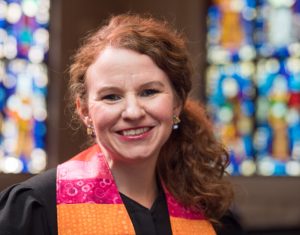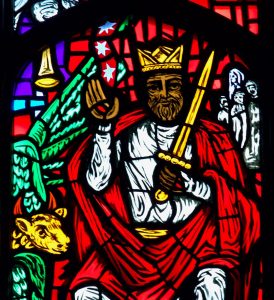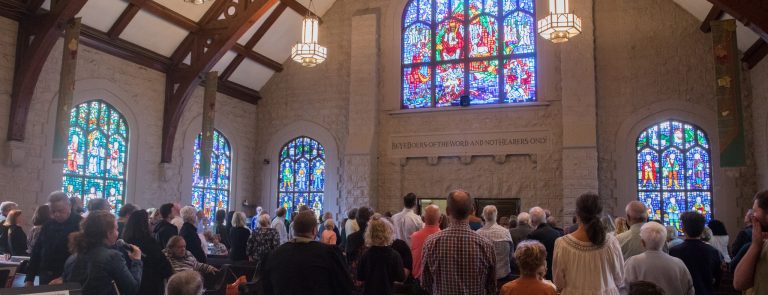Highland Baptist Church in Louisville transformed its Jesus stained glass window from white to brown to accurately reflect its ethnicity, to continue the congregation’s ongoing repair work, and to combat Christian nationalism.
“We wanted to correct the misrepresentation of Christ in our window of Revelation,” said Lauren Jones Mayfield, associate pastor for care and justice at sister congregation Cooperative Baptist Fellowship. “Palestinian Jews are not white Americans in appearance, and we know that what we filter into our minds through symbols, images and iconography can become representative of what we worship. »

Lauren Jones Mayfield
The racially transformed Jesus also negates “a Christian nationalist vibe that is hijacking American Christianity for the worse,” she said. “In our worship and in our Christology, we must do our best to reflect what we know to be true. »
Retinting of stained glass windows, which occurred on October 10, was the result of a multi-faceted, multi-year repair effort led by Highland. Its facets include liturgical expressions of confession and repentance for racism and white privilege, anti-racism advocacy work and financial contributions to grassroots community organizations, said Nancy Goodhue, the lay leader who chairs the task force. on repairs to the Church.
That group’s research found that the Church remained generally silent on the racial disparities that divided the city and continue to plague the community. The congregation also benefited from white privilege and the social and financial benefits that come with it, she said.
“We reap many benefits that black people have not enjoyed, which is why we are considering holding a repentance service. And we are addressing this problem now by confessing racism in our worship services.
Confront the images throughout installation was another component of the repair process, she added. “It has to do with our windows and other images in the church, including slaveholders in our stained glass windows and one in our fellowship hall.”
While the church’s founding in 1893 is postdated on slavery, some windows from the 1970s include images touting prominent Baptist slaveholders and slavery advocates. The congregation had become concerned about these signs and in 2021 hosted a visit from Black advisors on the reparations process and how to deal with depictions of slaveholders.
“We were wondering how to handle these images,” Jones Mayfield said. “Should we cover them with black cloth or desecrate them? Or should we just erect a plaque to draw attention and repent of the portrayals?
While advisors gave different answers regarding these windows, they were struck by the white stained glass window of Jesus in the Gothic sanctuary and were unanimous in agreeing that something had to be done.
“One of them used the term ‘idolatry'” to describe the window, Goodhue said.

Mary Alice Birdwhistell
That meeting started an internal discussion about how the potential expense of replacing the window would draw money from financial repairs, said Highlands Pastor Mary Alice Birdwhistell. “But where we’ve come to is that it’s not an ‘either-or’ because the imagery is important in what it communicates theologically.”
However, the financial impact was significantly mitigated by the fact that Jesus was re-altered rather than replaced.
Jones Mayfield said his first experience of seeing the altered figure of Christ was moving. “Seeing a brown Jesus was simply overwhelming. The way the light is reflected through the glass and all the subtleties are preserved is incredibly powerful.
But some young people in the congregation feared the church would let pride in the modified window overshadow the church’s dedication to the repair work, Jones Mayfield said. “We responded that it was neither our first step nor our last step. In some ways, this is a tangible step, but it also symbolizes what really matters in reparations: confessions, pleas and money. »
A Facebook user expressed a similar concern in a comment on Highland’s announcement regarding the brown Christ figure: “As long as they help people of color who need help with bills, food, housing , etc.… “
“This is a next step in the direction we felt led to take, and we realize there are many, many more steps to take.”
Birdwhistell replied that the congregation had reflected on this point: “Before this change in our windows, our first step was to create a Repairs Fund and commit to dedicating a portion of our budget each year to pay for repairs in our community. We have an advisory board made up of people of color right here in Louisville who help us make decisions about where and how these funds can best be used to meet exactly the type of needs you name above, focusing specifically on homeownership and education.
Furthermore, Birdwhistell said the historically and theologically accurate Christ window actually confirms the path of reparations the church is following.
“I love looking up and seeing it. They are just five small pieces (of glass): a face, two hands and feet. This is a next step in the direction we felt led to take, and we realize there are many more steps to take.

Newly retinted Christ window at Highland Baptist Church in Louisville, Kentucky.
Another big milestone was reached last year when the congregation voted to donate 1% of the church budget each year to local organizations that address wealth gap issues in black communities, including through employment and housing work, Goodhue said.
Highland is also looking to join or help develop coalitions of other organizations interested in making financial reparations a national cause, she said. “We hope to find other people like us who want to do this work and see a different kind of nation.” »
The ministry of reparations is a long-term ministry, Birdwhistell reiterated. “It would be great to find other congregations willing to tackle this issue and journey with us, but we recognize that change takes time, especially in congregations. »
She urged other congregations to take every small step possible in the movement for racial justice and reparations. “Just ask what’s the next step you could take in your context, because a few years ago we didn’t think we could take that step either.”
Related Articles:
Knowing a Church’s history of slavery can be a boost toward redemption, historians say
What should you do if you discover a history of slavery in your church, college or institution?


